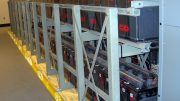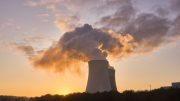Ben McLellan, Kyoto University
This article is part of a series on building the future of batteries. How can we create the batteries we’ll need to power our electronics, transport and industry, and what’s standing in the way? You can read the rest of the series here.
People are excited about batteries, from electric cars to Tesla’s 129 megawatt-hour energy storage project in South Australia. But one important issue is often overlooked: the raw materials needed to build this technology – where they come from and their environmental cost.
New types of batteries such as vanadium “flow batteries” still lag in comparison with the performance of lithium-ion ones (as used by Tesla). Other technologies face significant hurdles before they can be commercially available.
This means that, for now, demand for lithium-ion batteries for use in portable electronics, hybrid vehicles and electric tools will only grow. Lithium demand for batteries is forecast to increase dramatically, driving more than a doubling in total lithium demand by 2025.

This demand has led to enthusiastic investment, first in lithium and more recently in the electrode materials required for these batteries, including graphite, nickel and cobalt.
We need to think carefully about the security of the sources of lithium-ion battery materials, as well as the environmental impact of their extraction.
Where can we find lithium?
Getting lithium into a battery is not simply a matter of digging it up.
The current major producers of lithium are Australia, Chile, Argentina and China, with Australia and Chile accounting for about 75% of the total.
These four countries also have the largest reserves of lithium. Chile, in particular, is thought to have more than 50% of known economic reserves (the portion of mineral resources expected to be minable at a profit).
However, Argentina and Bolivia have so far identified more than 9 million tonnes each in lithium resources (a classification for minerals with more uncertainty about if and at what cost they can be extracted).
Because of the concentration of reserves in South America, the regions of highest lithium potential are often referred to as the “lithium triangle”. If battery power replaced oil, some analysts predict that South America would become the “new Middle East”.
The environmental impact of lithium mining
Lithium mining has different ecological impacts depending on how it’s extracted.
Australia, for example, mostly produces lithium from hard rock ores. Other countries, including those in South America, more often produce it from brines.
To produce lithium from ore, the ore is typically crushed. Then chemicals and high temperatures are used to separate the lithium from the rest of the rock.
Producing lithium this way requires land use changes – clearing land, digging mines and storing waste rock. Significant energy and chemical use are also needed to obtain to the final product.
For brines, a naturally occurring concentrated solution of lithium (mixed with other salts containing sodium, magnesium and potassium when it is found naturally) is pumped out of the ground. It is put in large ponds to evaporate excess water and separate the other salts for many months. The remaining lithium compound is then purified and processed.
For brines, the main environmental concern, especially in Chile, is that the extraction can impact water supply in desert areas. It also uses some chemicals for purification.
Many analysts consider that lithium from brines is preferable environmentally because the impacts are lower using present methods.
Of course, increasing demand might change this and increase the environmental cost: the brines could be evaporated more quickly using heat (possibly from fossil fuels or from concentrated solar energy). The size of the pond could also be expanded.
Where do we find the rest of the battery?
Graphite
Graphite reserves are dominated by three countries: Turkey (36%), Brazil (29%) and China (22%), but production is presently dominated by China. An estimate of 2015 production reported that China produced up to 82% of the world’s total, but there are often discrepancies in reporting.
Graphite can also be synthetically derived, but only natural graphite is considered here, as it is currently easier to produce.
Cobalt
Some materials needed for batteries are not extracted and refined in the same place. This is particularly true for cobalt: in 2015, Democratic Republic of Congo produced most of the mined cobalt, but China was the largest producer of the refined metal.
After these two major players, Canada and Australia play moderately important roles in both mining and refining. Australia is second on the list of reserves of cobalt, with around 14% of global reserves.
Nickel
Nickel is the least centralised of the metals considered here. It is found widely, mined widely, and in 2015, the dominant producers only held estimated shares of up to 20% (Philippines, mining) and 30% (China, refining). Australia is thought to have 24% of global reserves.
Environmentally, the extraction of cobalt and nickel is driven by the type and grade of ores, and their location.
Typically, ores that are easier to mine and extract are already being exploited, leaving deeper, more complex deposits for the future.
For this reason, unlike lithium, the ecological impact of these minerals is likely to increase. Deeper mines and lower grades lead to more waste rock, greater energy use tied to greenhouse gas emissions, and more chemicals used per tonne.
The supply chain risks
Turning minerals into batteries takes a supply chain, and each stage – mining, processing, refining, manufacturing – could present a bottleneck.
Manufacturers such as electric vehicle makers should be concerned that the supply of one of the key mineral components, or the processing and refining infrastructure, could become too centralised in a single country.
Without diverse source options, the possibility of supply restriction becomes more likely.
Consider the rare earths price peak between 2009 and 2012, which was caused by highly centralised supply. The majority of rare earths were produced in China at the time and the restriction of exports for ostensibly political reasons caused concern that there would be insufficient supply for components such as the magnets used in wind turbines and electric vehicle motors.
Currently, graphite is quite centralised because fewer countries produce it, but reserves are more diversified. With almost half of the world’s cobalt ore reserves concentrated in Democratic Republic of Congo for the foreseeable future, and with a large proportion of refining capacity located in China, the supply chain could be more vulnerable.
After all, it’s possible governments might again restrict supply.
In this scenario, Democratic Republic of Congo is not high on the list of preferred suppliers. It rates poorly on most World Bank indicators thanks to its tenuous political situation, while China rates better. But as China has shown in the case of rare earth elements, there is still uncertainty about its reliability as a supplier.
Where does that leave the lithium battery?
The supply of major materials for lithium batteries is not under threat any time soon, but demand is likely to open up new areas for extraction, bringing new risks.
The political situations of countries with large reserve shares and large shares in the processing of these metals can quickly become uncertain. Will countries like Bolivia allow unrestricted export of lithium? Will Democratic Republic of Congo or China restrict cobalt supply?
Environmentally, the lithium-ion battery’s future is also worrying. The production of electrode materials may become more environmentally damaging. On the other hand, the impact of the lithium supply itself is likely to improve.
![]() Ultimately, recycling lithium should play a part in mitigating political, environmental and economic risks in the future, but high rates of lithium battery recycling are yet to be seen.
Ultimately, recycling lithium should play a part in mitigating political, environmental and economic risks in the future, but high rates of lithium battery recycling are yet to be seen.
Ben McLellan, Honorary Senior Research Fellow, Kyoto University
This article was originally published on The Conversation. Read the original article.





